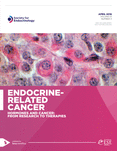Appendiceal neuroendocrine neoplasms: diagnosis and management
- Krystallenia I Alexandraki1⇑,
- Gregory A Kaltsas1,
- Simona Grozinsky-Glasberg2,
- Eleftherios Chatzellis1 and
- Ashley B Grossman3
- 1Department of Pathophysiology, National University of Athens, Greece
2Neuroendocrine Tumor Unit, Endocrinology and Metabolism Service, Department of Medicine, Hadassah-Hebrew University Hospital, Jerusalem, Israel
3Oxford Centre for Diabetes, Endocrinology and Metabolism, Churchill Hospital, University of Oxford, Oxford, UK
- Correspondence should be addressed to K Alexandraki; Email: alexandrakik{at}gmail.com
Abstract
Gastrointestinal neuroendocrine neoplasms (GI-NENs) are increasingly being recognised, while appendiceal NENs (aNENs) currently constitute the third most common GI-NEN. Appendiceal NENs are generally considered to follow an indolent course with the majority being localised at diagnosis. Thus, the initial surgical approach is not that of a planned oncological resection. Due to the localised nature of the disease in the majority of cases, subsequent biochemical and radiological assessment are not routinely recommended. Histopathological criteria (size, mesoappendiceal invasion, Ki-67 proliferation index, neuro- and angio-invasion) are mainly used to identify those patients who are also candidates for a right hemicolectomy. Goblet cell carcinoids are a distinct entity and should be treated as adenocarcinomas. Despite the absence of any substantial prospective data regarding optimal management and follow-up, recent consensus statements and guidelines have been published. The purpose of this review is to overview the published studies on the diagnosis and management of appendiceal NENs and to suggest a possible management protocol.
- Revision received 14 October 2015
- Accepted 19 October 2015
- Made available online as an Accepted Preprint 19 October 2015
- © 2016 Society for Endocrinology















